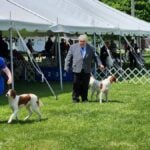
Home » National Specialties Bespeak History

It’s all very exciting, maybe even tense—the National Specialty! Who will be there and what dogs will they have? Now, of course, is the PRESENT, but a National is so much more than that; it is the PAST and the FUTURE as well; your breed’s history, all at one time and in one venue.
I was preparing to judge an Irish Wolfhound Specialty. So, I checked the website for information and a review when I was suitably impressed with an article I found there by Joel Samaha whose IW book I had read years ago and with whom I had observed in the ring at one time.

I was so impressed with his words that I wanted to share them with others. From Joel’s 1985 Introduction to Judging Irish Wolfhounds—A Guide, I quote:
“A National Specialty brings together many dogs from all over the country and even from other countries. It affords a rare opportunity to see dogs across a wide spectrum who in their owners’ judgment represent the best they have. Viewed from a broad perspective, these dogs enable us to assess our breed’s past, present and future. Dogs in their prime—concentrated in the Bred by Exhibitor, American Bred, Open and Specials classes—represent the breed’s present state. Also in evidence is our deep debt to the past. We glimpse that past in the Veterans classes first hand and it speaks to us indirectly through the heritage displayed in pedigrees from all classes.
We must never forget this heritage in our preoccupation with the present. Not only do we see the present and the past, in the puppies, yearlings and novices is revealed our hope for the breed’s future. They are a gauge to the direction we are going. From them, we can assess to what extent we are fulfilling our custodial responsibility to leave the breed in at least as good a condition as we found it.
Attending a Specialty, then, is obviously a valuable opportunity to learn about our breed. But it can be overwhelming, especially to novices who wonder how best to reap the benefits from this experience. In order to help you follow the judging, I have outlined my procedure for deciding where to place the dogs in each class. I have also included some comments about each step. I hope they will give you a little idea of what I am doing and why. Use this guide and commentary not only to follow what I am doing but also to clarify your own ideas. I believe firmly, and urge you strongly, to make your own decisions about the dogs. Everyone has an opinion. Compare your decision with mine and consider why you prefer some to others and why one is your choice for Best in Show.”
Joel also authored a Wolfhound book, The Complete Irish Wolfhound, Howell Book House, 1991 last printing. He easily takes us through Wolfhound history in the U.S. and simultaneously traces Wolfhounds from early history, near extinction, and the nineteenth century restoration. His insights are not just “wolfhound” but “dog world” in general. Worth reading.
I am using the Wolfhound drawings to support his statements and for summarizing his thoughts. You must substitute your breed for his breed.

As you observe the dogs standing, assess four critical features:
Then together around, determine not soundness yet (that will come with the individual exam), but the four critical traits again. You might be surprised. Best stacked is often least typical moving, bringing to the fore the best stacked’s type faults.
Since we know that no dog is perfect, keep an open mind. Your Breed Standard describes a range, not a point on a spectrum, of what is correct. Reasonable people can disagree about the meaning in a Standard. It’s okay. Discussion and even disagreement enhances one’s understanding. Your job, in evaluating dogs, is to find the ones that are closest to an ideal in your mind’s eye. Knowing the purpose of the breed (A MUST) will determine necessary bone and substance for your breed, and front and rear properties needed to fulfill a breed’s purpose. Evaluating structure requires feeling and observing together.
It goes without mentioning that ribbing, length and spring, is important for any breed to accommodate and protect heart and lungs, the vital organs. As one gets into breed specificity, that head is all-important. Its features are also determined largely by the purpose of the breed. Of course, aesthetics also plays a part.
Tail, length and set, are vitally important. Your Standard and breed’s purpose will determine the degree of slope to the croup and the tail set.
Balance, both moving and standing, so often stated but often misunderstood, is essential: shape, breadth and depth, lengths and substance. A balanced dog is at rest. He is comfortable. No need for cranking into a stance or jerking the head up or down while in motion. He stands comfortably and moves easily.
As you approach a new breed, how do you know what to look for and what is important?
The very first paragraph of most Standards will give you guidance. If not there, then use the breed’s purpose to solve your dilemma.

As you observe the dogs standing, assess four critical features: shape, presence, quality, and balance.
I heartily recommend the reading of Joel’s IW book for perspective on the dog world over the decades. Go to the IWclubofamerica.org website to find the material from which I have drawn for this article. All is worth reading.
Know your breed’s purpose and enjoy history at your National.
